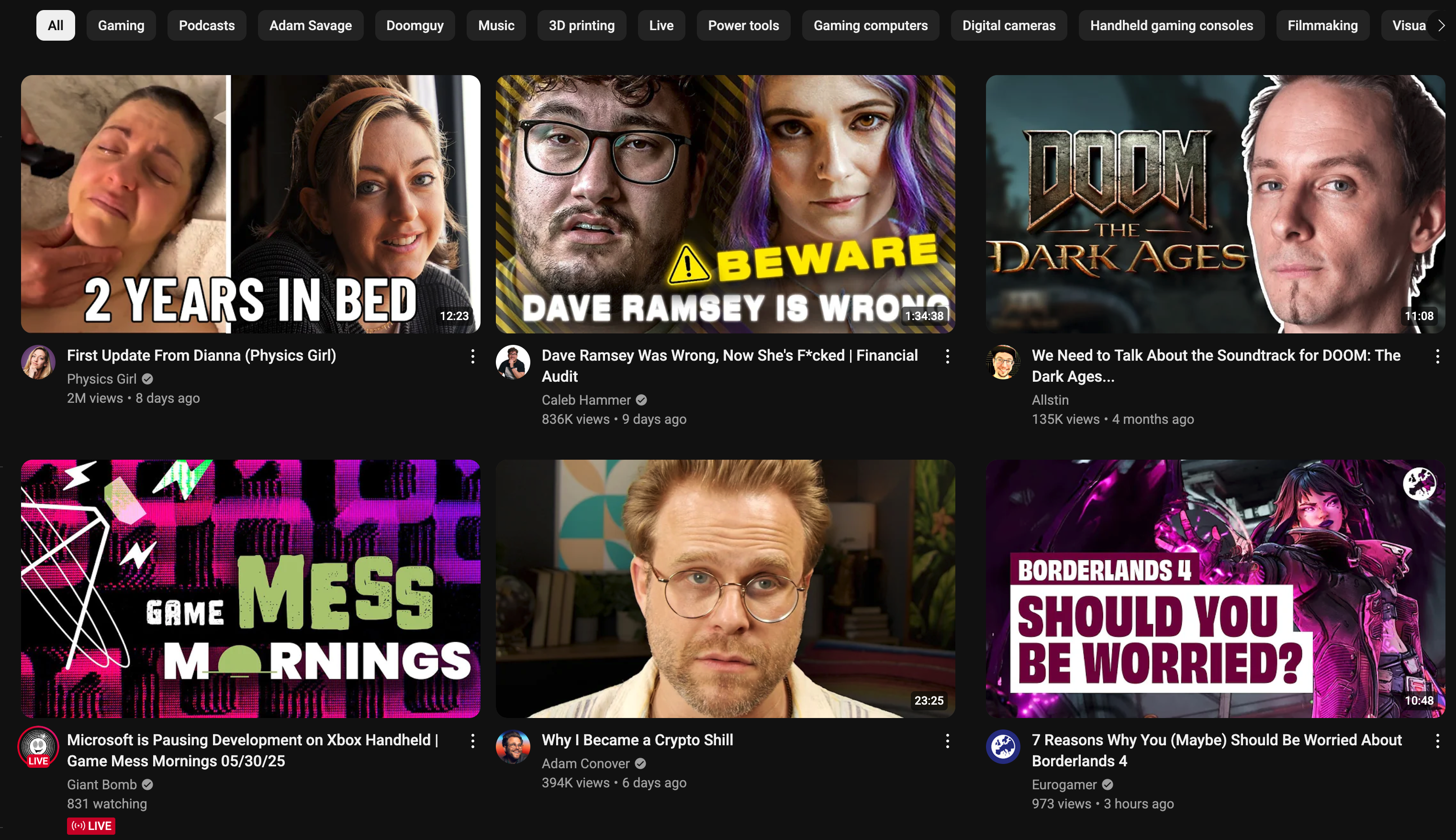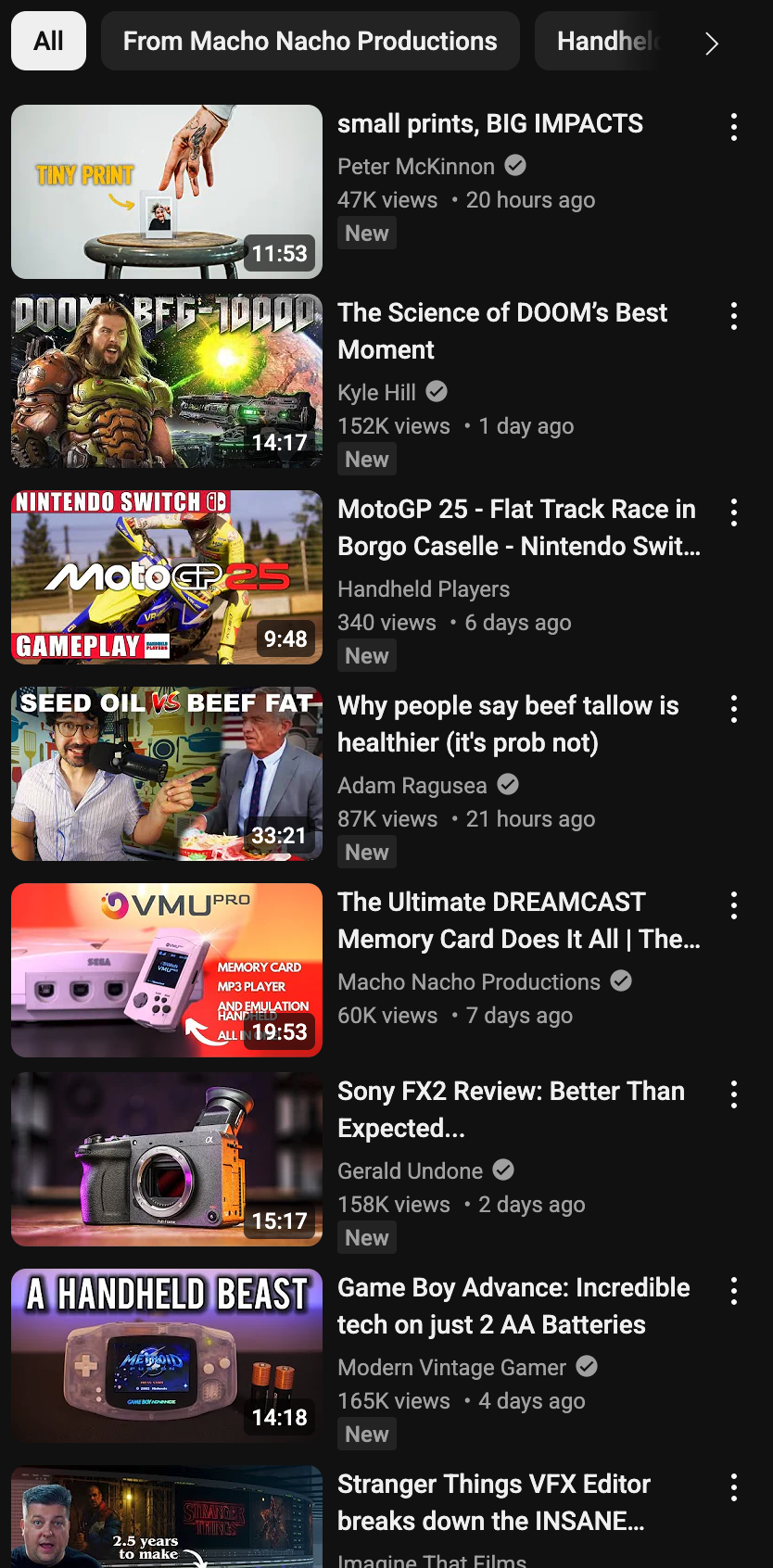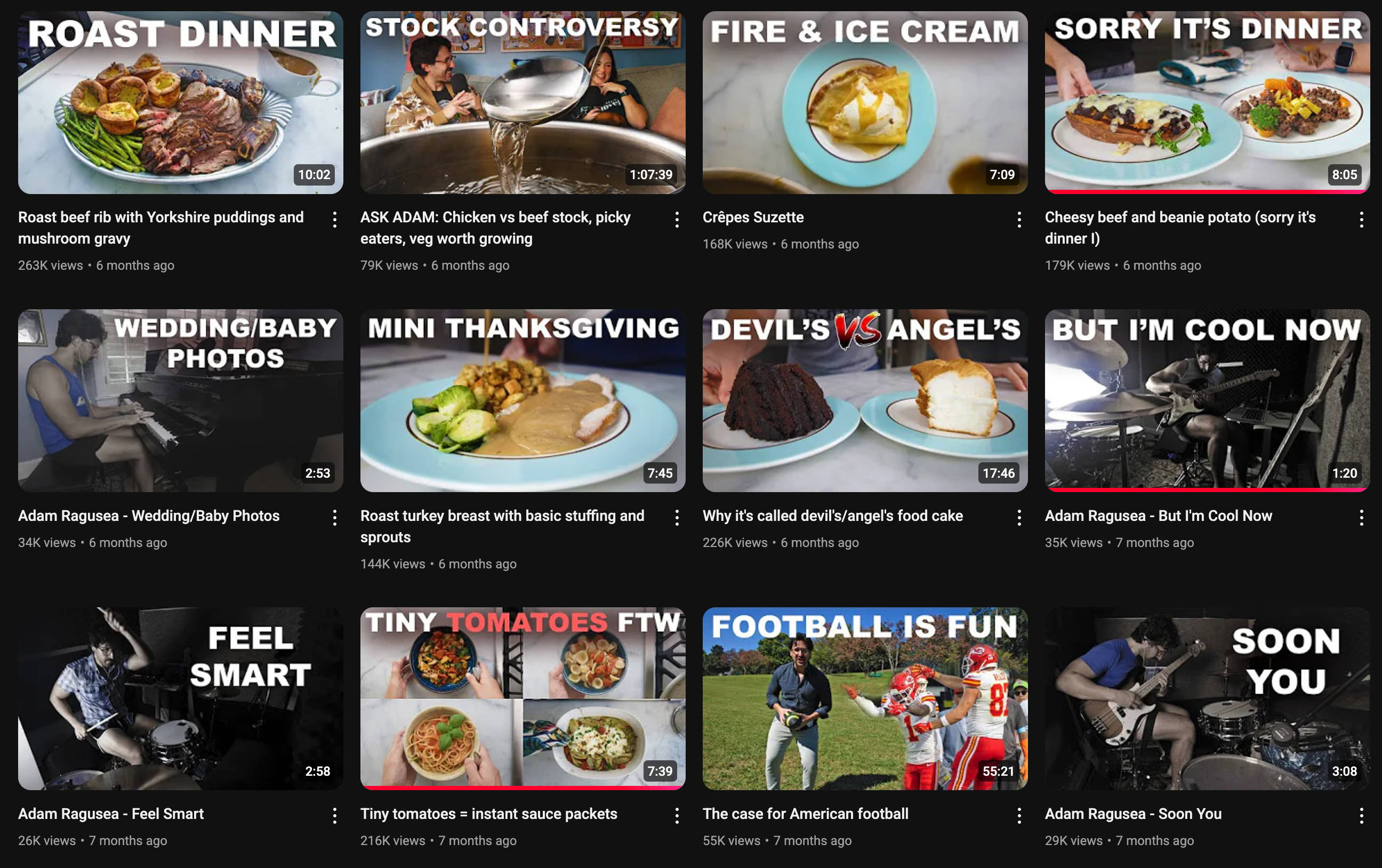Yes, you should start that new YouTube channel

Every YouTuber, streamer, “content creator” [shudders] eventually struggles with the same question: Should you start another YouTube channel? Should you try to cram everything on one channel and make it work, should you make new channels for every new type of video, or just give up?
I’ve been on YouTube since 2006, I’ve worked for YouTube MCNs, served as a consultant to many large YouTube channels and streamers, spoken at length with YouTube staff and many creators running large channels, and been full-time as a content creator for more than 10 years now – so let me try to answer this question.
YouTube, and its algorithms, is a fickle beast. The rules of the game are constantly changing, adapting, sometimes regressing, focusing on new (or old) things, and being obscured by YouTube itself. New competition floods the site every day, and new formats keep shifting the playing field.
We may never know all of the rules or be able to keep up with them fully, but the platform’s primary goal remains forever constant: Figure out what the viewer wants to watch, and serve them a never-ending feed of that so they watch as many videos as possible (and make YouTube as much advertising revenue as possible).

Niche – or specialized, focused on a specific topic – YouTube channels have been the backbone of YouTube’s success from the very beginning. Whether you stumbled upon goofy comedy skits from WheezyWaiter, a makeup tutorial from Panacea81, or a goofy introspective Call of Duty gameplay commentary from SeaNanners while he cooks a delicious dinner – YouTube was the place you could find a channel that was seemingly “made just for you” to bring you videos you could connect with, relate to, laugh at, or learn from. The early UX was a bit spartan, but the direction the site has always moved towards was of trying to get you more of that thing you enjoyed watching.
Now we have complex algorithms and personalized notifications to make sure (for better or worse) that you keep watching more and more content. Homepage, sidebar suggested videos, “Watch Next”, the Shorts feed – each of these elements gets their own modified version of YouTube’s recommendation algorithms, designed to provide new opportunities along the “funnel” of viewing content.
Homepage: Sparks interest in new videos (or repeat viewings of commonly-rewatched or recently trending-again videos) based on videos and channels you’ve watched before. This can be new videos of a similar interest from channels you’re subscribed to (or watch regularly) or videos on a relevant topic to what you often watch.
These are more of the “top of funnel” to get you down a new rabbit hole and starting a new watch session.Watch Next: These show up after you finish a video and either directly continue you through the funnel via the next episode in a series, a video directly related to what you just watched, or something YouTube’s expected profile of you might want to watch.
Sidebar Suggestions: These show next to a video and often directly relate to what you’re currently watching, but also include some options that are less relevant to what you’re watching at this moment but more relevant to your profile as a viewer (in case you get bored of what you’re watching now).
These recommendations can get highly fine-tuned. YouTube builds up a virtual version of you based on watch history, viewing habits (device type, time of day, average viewing session length, likelihood of jumping around on topics or sticking with a singular topic, demographics information, etc.), and subject matter and tries to deliver things it thinks will be interesting to you as a person, beyond a viewer of a singular video.

All of these systems foster an environment in which creators have the ability to quickly grow a channel on any given topic, should they show up with high quality videos and an understanding of how to “play the game” for growth. If you jump in (ideally into a content area with a bit of a gap in coverage) making great, unique videos on ranking the best pasta noodles, or doing high-fashion makeup while riding a unicycle, or using Lego bricks for car repair, YouTube will keep delivering your videos to the audience that is most interested in them.
There’s never been a better time to create a YouTube channel on a specific topic with expertise, a unique approach, a great personality, etc. and succeed.*
[* I’d argue that the current over-emphasis on extraneous monetization tactics such as YouTube Shopping, mini-games, and YouTube’s uncharacteristic fear of TikTok flooding the site with Shorts is actually doing more harm than good and disrupting the algorithms in very messy ways, but the consequences of this impact established channels moreso than new channels. Leveraging YouTube Shorts as part of a growth process in some niches can be beneficial. Regardless, the algorithms at play absolutely provide unprecedented opportunities for growth for niche channels far better than the site has ever had before.]
The downside of this, is that channels who don’t conform to a specific niche or sub-niche tend to struggle. Growth is slower, it’s more difficult to get new videos seen, and YouTube itself struggles to figure out how to recommend your videos to viewers.
YouTube will claim that a channel, taken on the whole, doesn’t “matter.” That “all that matters” is the quality of an individual video and how well it appeals to viewers and performs. That is technically true, but there’s still a lie of omission. A video’s performance doesn’t exist in a vacuum. YouTube cannot evaluate every individual video and determine who to show it to on its own without some sort of viewership data.
So your video is first shown to existing subscribers and regular viewers via the homepage (if YouTube can determine a slot for it to fit in based on all the previously-discussed factors). If that video is a deviation from your normal content, a few things will happen:
- First, YouTube will struggle to determine who that initial “test audience” should be to begin with. If you primarily run a gaming channel and post a cooking video, the system won’t just surface your video to all of your existing viewers. It has to find a cross-section of viewers of your kind of gaming content who also watch cooking content similar to this new video.
This lowers the initial reach, before anyone has even seen the video. - Second, YouTube surfaces this video to said test audience. Inevitably it will not be a perfect match for everyone. Normal viewers aren’t going to recognize the video and click on something more recognizable. Some people who do recognize your channel won’t be interested in a cooking video. Many more people won’t be interested in this video right now, even if they might watch it another time.
This almost always leads to a low CTR (click-through ratio) on your video, meaning only a small percentage of the number of people who saw your video show up on a YouTube feed actually clicked on it.

It is still possible for a video to recover from this and eventually find its audience should YouTube get good enough viewer data from the initial wave of impressions – but that often doesn’t end up happening, and when it does it can take years to bounce back.
This leads to variety channels struggling to really find their audience to begin with, and established channels who want to pivot struggling to get any viewership on their new niche. (Or alternatively, having that new niche completely dominate viewership on the channel and destroying any viability of the original niche.)
It’s easy to find this a defeating concept, to be discouraged by this. To feel trapped. “What happened to “Broadcast Yourself”? Why can’t I post what I want?”
But really, it’s important to think about it from the viewer’s perspective. If you go to the produce aisle at the grocery store to get your weekly pickup of apples (your favorite fruit), and the vendor for that aisle carrying artichokes in one of the apple slots – you’re going to be confused or frustrated by this choice, skip over the artichokes that you don’t like or didn’t ask for, and now have less apples right in front of you to even choose from in the first place. When the grocery store has a limited number of slots to present you with food options, and a vendor chooses to insert something you didn’t expect in that aisle or slot with something you weren’t expecting or wanting, the ripple effect goes pretty far.
As YouTube’s Creator Liaison, Rene Ritchie (a veteran YouTuber himself) put it:
“[…] if they expect a tasty cooking video, click on it, get it, and love it, it's super easy to keep recommending it to the same people who love tasty cooking videos. If instead they get a dance video, they maybe don't click, they maybe don't like it, and then the algorithm has to try to figure out why and what other audience might enjoy it instead, and that might take time.”
This is important for scaling businesses based on YouTube channels, even if you cover multiple topics within the same (or very similar) niches.
Take Linus Media Group, for instance. They run many channels under the “tech videos” umbrella:
Linus Tech Tips – Big name reviews, critical content, buyer’s guides, build guides, project videos
ShortCircuit – First impressions and old school “unboxing” videos
TechQuickie – “Explainer” style videos
TechLinked – Tech News & event coverage
GameLinked – Gaming news & event coverage
LMG Clips – Clips and excerpts from live streams and bigger content that stand alone
All of this content falls under the tech or tech-adjacent umbrella, but have been able to support a massive 100+ person operation and media empire by niching-down to specific focuses and feeding the audiences for those niches on unique outlets.
We see this again in MKBHD:
Main Channel – tech reviews and event coverage
The Studio – BTS content, lower-stakes content, and coverage from staff
Auto Focus – car tech videos
WAVFRM Podcast – Dedicated podcast from Marques and staff
Waveform Clips – Clips of the podcast
Examples of this are too many to list.

Similar logic is used by product manufacturers who often create sub-brands of different products targeted at different types of users to help reduce market confusion.
The downsides, of course, are that each individual channel requires a bit more concentrated effort to run efficiently if your goal is for those channels to each be a sustainable full-time career.
But even if it’s just a secondary outlet for a business’s customer outreach and relations, the benefits are still there. Going back to the focus on what the viewer wants: Are the same people who want commercials for your product or software the same people that want detailed guides on how to manufacture, build with, market, or sell your product or service to other customers? Are the people who want trailers of your latest video game the same people that want guides on using your game engine or HR management system? Are the people who want to learn to cook amazing budget meals the same people who want to learn to cast their own iron pans?
Sometimes that answer is yes, but statistically that answer is usually no. You can always double-dip with multiple channels, cross-pollinate via cross-promotion, and benefit from that, but you can’t really undo the damage of having too much unrelated content together on one channel.
While the current AI-generated, short attention spanned, corporate hellscape that clouds the surface of YouTube definitely feels like a far cry from the mid-00s “Broadcast Yourself” platform that changed web video forever, niche channels with unique videos that appeal to a very specific audience have never stopped being the backbone. Mainstream viewership might primarily fall on talk show clips, music videos, and Vine TikTok compilations; but the regular, return viewers that make up the viewership for the majority of YouTube channels out there are from people exploring their individual interests and finding more content that keeps them locked in.
So go ahead, make that new YouTube channel for that new idea you had. Don’t be afraid to branch out. Started a weird vlog channel 8 years ago and unsure whether or not to keep it going or to just post that to main? Keep that ish on your side channel. Make more of them. Keep it niche and keep it weird. You’ll find some of your biggest fans that way.
But please, for the love of everything digitally-amalgamated, don’t ask your viewers “What do you want to see?”. The moment you do that is the moment you’ve lost.
